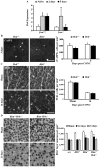JUN regulates early transcriptional responses to axonal injury in retinal ganglion cells
- PMID: 23648575
- PMCID: PMC3700614
- DOI: 10.1016/j.exer.2013.04.021
JUN regulates early transcriptional responses to axonal injury in retinal ganglion cells
Abstract
The AP1 family transcription factor JUN is an important molecule in the neuronal response to injury. In retinal ganglion cells (RGCs), JUN is upregulated soon after axonal injury and disrupting JUN activity delays RGC death. JUN is known to participate in the control of many different injury response pathways in neurons, including pathways controlling cell death and axonal regeneration. The role of JUN in regulating genes involved in cell death, ER stress, and regeneration was tested to determine the overall importance of JUN in regulating RGC response to axonal injury. Genes from each of these pathways were transcriptionally controlled following axonal injury and Jun deficiency altered the expression of many of these genes. The differentially expressed genes included, Atf3, Ddit3, Ecel1, Gadd45α, Gal, Hrk, Pten, Socs3, and Sprr1a. Two of these genes, Hrk and Atf3, were tested for importance in RGC death using null alleles of each gene. Disruption of the prodeath Bcl2 family member Hrk did not affect the rate or amount of RGC death after axonal trauma. Deficiency in the ATF/CREB family transcription factor Atf3 did lessen the amount of RGC death after injury, though it did not provide long term protection to RGCs. Since JUN's dimerization partner determines its transcriptional targets, the expression of several candidate AP1 family members were examined. Multiple AP1 family members were induced by axonal injury and had a different expression profile in Jun deficient retinas compared to wildtype retinas (Fosl1, Fosl2 and Jund). Overall, JUN appears to play a multifaceted role in regulating RGC response to axonal injury.
Copyright © 2013 Elsevier Ltd. All rights reserved.
Figures








Similar articles
-
Together JUN and DDIT3 (CHOP) control retinal ganglion cell death after axonal injury.Mol Neurodegener. 2017 Oct 2;12(1):71. doi: 10.1186/s13024-017-0214-8. Mol Neurodegener. 2017. PMID: 28969695 Free PMC article.
-
Activating Transcription Factor 3 (ATF3) Protects Retinal Ganglion Cells and Promotes Functional Preservation After Optic Nerve Crush.Invest Ophthalmol Vis Sci. 2020 Feb 7;61(2):31. doi: 10.1167/iovs.61.2.31. Invest Ophthalmol Vis Sci. 2020. PMID: 32084268 Free PMC article.
-
JNK2 and JNK3 are major regulators of axonal injury-induced retinal ganglion cell death.Neurobiol Dis. 2012 May;46(2):393-401. doi: 10.1016/j.nbd.2012.02.003. Epub 2012 Feb 14. Neurobiol Dis. 2012. PMID: 22353563 Free PMC article.
-
Evaluating the Evidence for Neuroprotective and Axonal Regenerative Activities of Different Inflammatory Cell Types After Optic Nerve Injury.Mol Neurobiol. 2025 May;62(5):6212-6227. doi: 10.1007/s12035-024-04679-3. Epub 2024 Dec 30. Mol Neurobiol. 2025. PMID: 39738875 Free PMC article. Review.
-
Intrinsic survival mechanisms for retinal ganglion cells.Eur J Ophthalmol. 1999 Jan-Mar;9 Suppl 1:S12-6. doi: 10.1177/112067219900901S08. Eur J Ophthalmol. 1999. PMID: 10230600 Review.
Cited by
-
Tetrandrine alleviates inflammation and neuron apoptosis in experimental traumatic brain injury by regulating the IRE1α/JNK/CHOP signal pathway.Brain Behav. 2022 Dec;12(12):e2786. doi: 10.1002/brb3.2786. Epub 2022 Nov 14. Brain Behav. 2022. PMID: 36377337 Free PMC article.
-
ROR2 induces cell apoptosis via activating IRE1α/JNK/CHOP pathway in high-grade serous ovarian carcinoma in vitro and in vivo.J Transl Med. 2019 Dec 26;17(1):428. doi: 10.1186/s12967-019-02178-x. J Transl Med. 2019. PMID: 31878941 Free PMC article.
-
BAX-Depleted Retinal Ganglion Cells Survive and Become Quiescent Following Optic Nerve Damage.Mol Neurobiol. 2020 Feb;57(2):1070-1084. doi: 10.1007/s12035-019-01783-7. Epub 2019 Oct 31. Mol Neurobiol. 2020. PMID: 31673950 Free PMC article.
-
Axon injury signaling and compartmentalized injury response in glaucoma.Prog Retin Eye Res. 2019 Nov;73:100769. doi: 10.1016/j.preteyeres.2019.07.002. Epub 2019 Jul 10. Prog Retin Eye Res. 2019. PMID: 31301400 Free PMC article. Review.
-
Increased Susceptibility and Intrinsic Apoptotic Signaling in Neurons by Induced HDAC3 Expression.Invest Ophthalmol Vis Sci. 2021 Aug 2;62(10):14. doi: 10.1167/iovs.62.10.14. Invest Ophthalmol Vis Sci. 2021. PMID: 34398198 Free PMC article.
References
-
- Aguilera C, Nakagawa K, Sancho R, Chakraborty A, Hendrich B, Behrens A. c-Jun N-terminal phosphorylation antagonises recruitment of the Mbd3/NuRD repressor complex. Nature. 2011;469:231–235. - PubMed
-
- Anderson DR, Hendrickson A. Effect of intraocular pressure on rapid axoplasmic transport in monkey optic nerve. Invest Ophthalmol. 1974;13:771–783. - PubMed
-
- Bahr M. Live or let die - retinal ganglion cell death and survival during development and in the lesioned adult CNS. Trends Neurosci. 2000;23:483–490. - PubMed
Publication types
MeSH terms
Substances
Grants and funding
LinkOut - more resources
Full Text Sources
Other Literature Sources
Medical
Molecular Biology Databases
Research Materials
Miscellaneous

